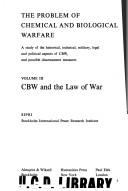| Listing 1 - 10 of 3804 | << page >> |
Sort by
|

ISBN: 9185114162 9185114189 9185114170 Year: 1971 Publisher: Stockholm Almqvist and Wiksell
Abstract | Keywords | Export | Availability | Bookmark
 Loading...
Loading...Choose an application
- Reference Manager
- EndNote
- RefWorks (Direct export to RefWorks)

ISBN: 9185114170 Year: 1973 Publisher: Stockholm Almqvist & Wiksell
Abstract | Keywords | Export | Availability | Bookmark
 Loading...
Loading...Choose an application
- Reference Manager
- EndNote
- RefWorks (Direct export to RefWorks)
Book
ISBN: 0297781391 Year: 1982 Publisher: London : Weidenfeld & Nicolson,
Abstract | Keywords | Export | Availability | Bookmark
 Loading...
Loading...Choose an application
- Reference Manager
- EndNote
- RefWorks (Direct export to RefWorks)
Book
ISBN: 9781441181978 Year: 2012 Publisher: New York : Continuum,
Abstract | Keywords | Export | Availability | Bookmark
 Loading...
Loading...Choose an application
- Reference Manager
- EndNote
- RefWorks (Direct export to RefWorks)
Book
ISBN: 039471363X 9780394713632 Year: 1983 Publisher: New York (N.Y.) : Vintage books,
Abstract | Keywords | Export | Availability | Bookmark
 Loading...
Loading...Choose an application
- Reference Manager
- EndNote
- RefWorks (Direct export to RefWorks)
Book
ISBN: 836489580X 8364895796 Year: 2016 Publisher: Warszawa Poland : Polski Instytut Spraw Międzynarodowych,
Abstract | Keywords | Export | Availability | Bookmark
 Loading...
Loading...Choose an application
- Reference Manager
- EndNote
- RefWorks (Direct export to RefWorks)
“NATO exists for peace by collective security”. This quote by Lord Ismay, the first Secretary General of NATO, encapsulates the central purpose of the Alliance, which has been directly tasked with preserving the peace in Europe for over 60 years, longer than any other organisation on the continent. Hence, today’s considerations on the future of NATO, its policies and capabilities, are in fact tantamount to deliberations on the future of European peace and on how to maintain it. At the same time, answers to pressing threats and challenges are urgently sought, as the European security environment is undergoing a structural change. This transformation is primarily characterised by rapid developments and significant interconnections between multiple threats of a military, asymmetric and non-military nature. After Russia forcibly annexed Crimea and then intervened militarily in eastern Ukraine, military aggression, considered a remote threat for the last two decades, is back on the European security landscape. In the strategic vicinity of Europe, non-state actors driven by radical ideology, particularly the so-called Islamic State in Iraq and Syria (ISIS) and Al-Qaeda, have conquered large amounts of territory and established quasi-states, which enabled them to inspire or directly control terrorist networks in Europe, North Africa and the Sahel. Attacks such as those in Paris, Brussels or Bamako testify to their growing capabilities.

ISBN: 0387950761 Year: 2002 Publisher: New York (N.Y.) : Copernicus books,
Abstract | Keywords | Export | Availability | Bookmark
 Loading...
Loading...Choose an application
- Reference Manager
- EndNote
- RefWorks (Direct export to RefWorks)
Book
ISBN: 024559485X Year: 1968 Publisher: London : Harrap,
Abstract | Keywords | Export | Availability | Bookmark
 Loading...
Loading...Choose an application
- Reference Manager
- EndNote
- RefWorks (Direct export to RefWorks)
Book
ISBN: 9780879073299 Year: 2009 Publisher: Trappist Cistercian Publications
Abstract | Keywords | Export | Availability | Bookmark
 Loading...
Loading...Choose an application
- Reference Manager
- EndNote
- RefWorks (Direct export to RefWorks)
How did the monks of the Egyptian desert fight against the demons that attacked them with tempting thoughts? How could Christians resist the thoughts of gluttony, fornication, or pride that assailed them and obstructed their contemplation of God? According to Evagrius of Pontus (345 '399), one of the greatest spiritual directors of ancient monasticism, the monk should talk back to demons with relevant passages from the Bible. His book Talking Back (Antirrhêtikos) lists over 500 thoughts or circumstances in which the demon-fighting monk might find himself, along with the biblical passages with which the monk should respond. It became one of the most popular books among the ascetics of Late Antiquity and the Byzantine East, but until now the entire text had not been translated into English. From Talking Back we gain a better understanding of Evagrius's eight primary demons: gluttony, fornication, love of money, sadness, anger, listlessness, vainglory, and pride. We can explore a central aspect of early monastic spirituality, and we get a glimpse of the temptations and anxieties that the first desert monks faced.
Book
ISBN: 0722170289 9780722170281 Year: 1983 Publisher: London : Sphere,
Abstract | Keywords | Export | Availability | Bookmark
 Loading...
Loading...Choose an application
- Reference Manager
- EndNote
- RefWorks (Direct export to RefWorks)
| Listing 1 - 10 of 3804 | << page >> |
Sort by
|

 Search
Search Feedback
Feedback About UniCat
About UniCat  Help
Help News
News